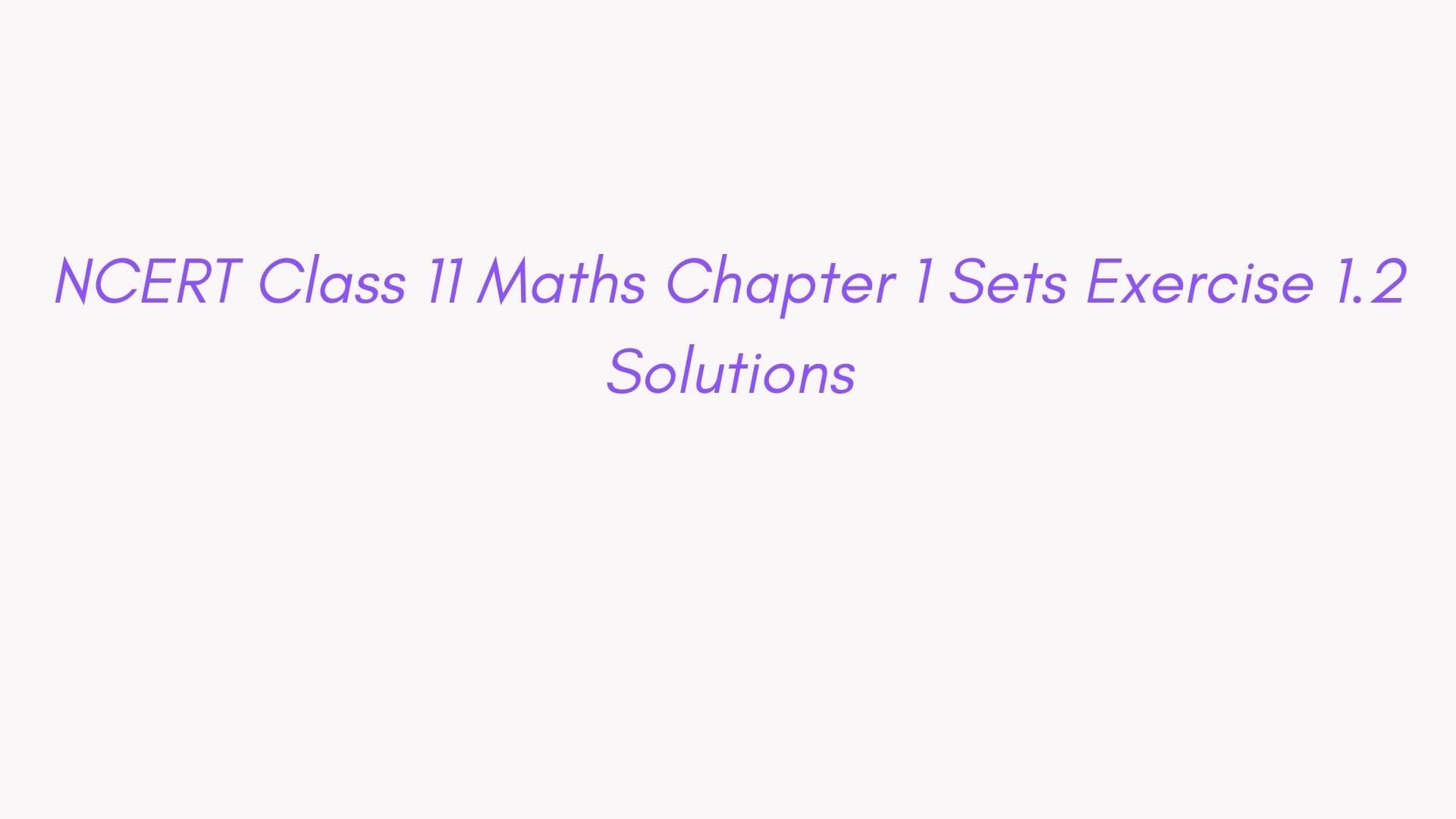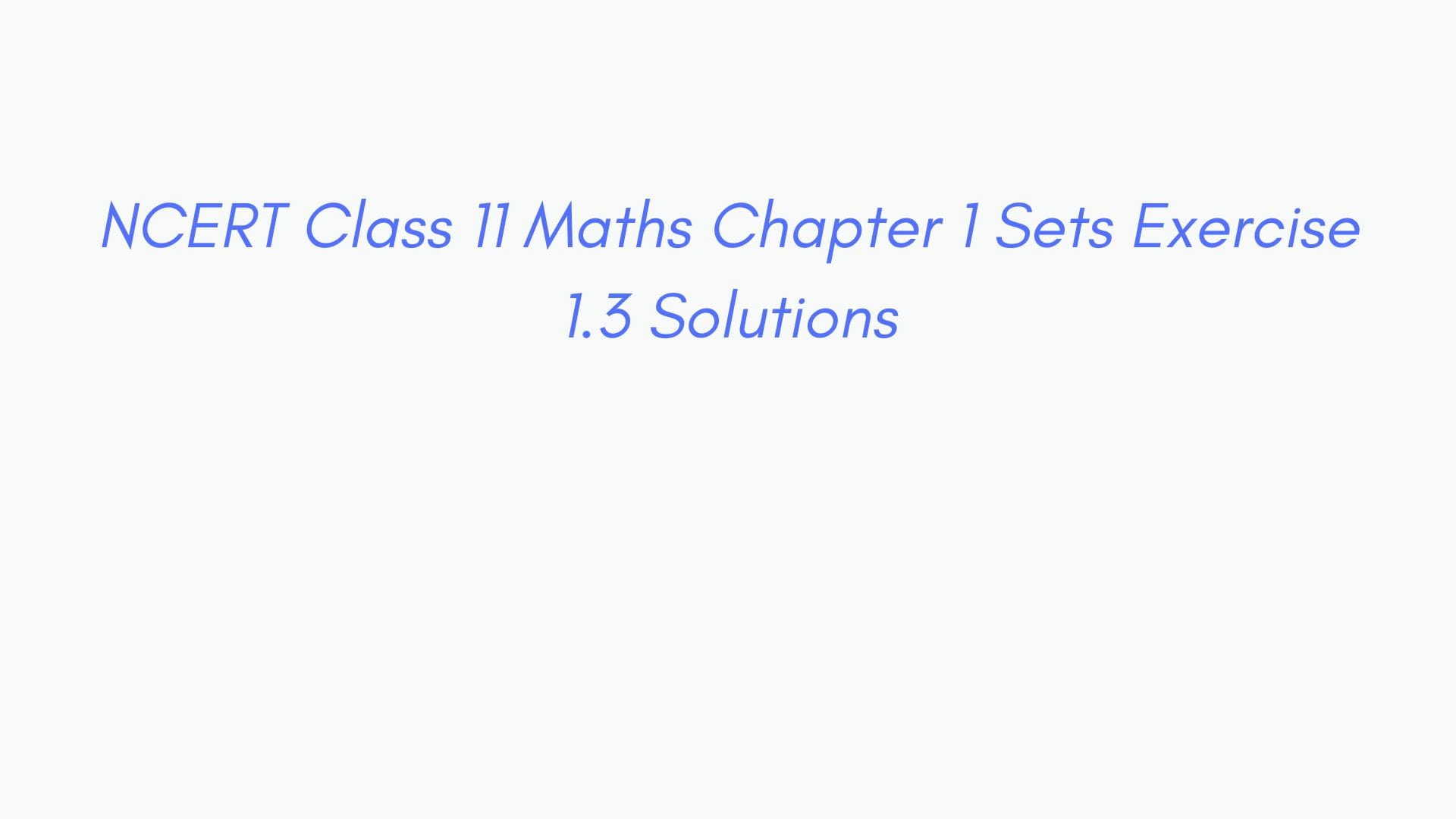Written by : Anmol Gupta
7 mins read time
NCERT Class 11 Maths Chapter 1 Sets Exercise 1.2 Solutions
Table of Contents
Solved Examples of Exercise 1.2
Example 7. Find the pairs of equal sets, if any, give reasons:
A = {0}
B = {x : x > 15 and x < 5}
C = {x : x – 5 = 0 }
D = {x: x2 = 25}
E = {x : x is an integral positive root of the equation x2 – 2x –15 = 0}.
Answer 7. Simplifying the given sets
A = {0}, B = φ, C = {5}, D = {-5, 5}, E = {5}
We solve x2 – 2x –15 as
x2 – 5x + 3x –15 = 0
x(x-5) + 3(x-5) = 0
We get x = -3 and x=5
Integral positive root of equation is 5
From above sets, the only pair of equal sets is C and E
Example 8. Which of the following pairs of sets are equal? Justify your answer
(i) X, the set of letters in “ALLOY” and B, the set of letters in “LOYAL”.
(ii) A = {n : n ∈ Z and n2 ≤ 4} and B = {x : x ∈ R and x2 – 3x + 2 = 0}.
Answer 8.
(i) X = {A, L, O, Y} = B
(ii) A = {–2, –1, 0, 1, 2}, B = {1, 2}. Since 0 ∈ A and 0 ∉ B, A and B are not equal sets.
Exercise 1.2 solved questions
Question 1. Which of the following are examples of the null set
(i) Set of odd natural numbers divisible by 2
(ii) Set of even prime numbers
(iii) { x : x is a natural numbers, x < 5 and x > 7 }
(iv) { y : y is a point common to any two parallel lines}
Answer 1.
(i) It is a null set as there is no odd natural natural number divisible by 2
(ii) The only even prime number is 2, so it is not a null set
(iii) Null set as there is no natural number less than 5 and greater than 7
(iv) Null set as there is no common point to any two parallel lines
Question 2. Which of the following sets are finite or infinite
(i) The set of months of a year
(ii) {1, 2, 3, . . .}
(iii) {1, 2, 3, . . .99, 100}
(iv) The set of positive integers greater than 100
(v) The set of prime numbers less than 99
Answer 2.
(i) Finite Set as there are 12 months in a year which is finite
(ii) Infinite Set as number of elements are infinite in the given set
(iii) Finite Set as definite number of elements 100 are there in the set
(iv) Infinite Set as infinitely many positive integers are there greater than 100
(v) Finite Set as there definite number of prime numbers less than 99
Question 3. State whether each of the following set is finite or infinite:
(i) The set of lines which are parallel to the x-axis
(ii) The set of letters in the English alphabet
(iii) The set of numbers which are multiple of 5
(iv) The set of animals living on the earth
(v) The set of circles passing through the origin (0,0)
Answer 3.
(i) Infinite Set as there will be infinitely many lines parallel to the x-axis
(ii) Finite Set as there are definite number of letters which is 26 in the given set
(iii) Infinite Set as there are infinitely many multiples of 5
(iv) The set of animals living on the Earth is a finite set. At any given point in time, the number of animals currently living on Earth is countable and limited, even though it may be a very large number. Since we can, in principle, count or estimate the total number of living animals, the set is finite. However, if you were talking about all animals that have ever lived in the past, live now, or will live in the future, then that could be considered an infinite set (potentially infinite). But currently living animals form a finite set.
(v) Infinite Set as infinitely many circle can be drawn passing through origin (0,0)
Question 4. In the following, state whether A = B or not:
(i) A = { a, b, c, d } B = { d, c, b, a }
(ii) A = { 4, 8, 12, 16 } B = { 8, 4, 16, 18}
(iii) A = {2, 4, 6, 8, 10} B = { x : x is positive even integer and x ≤ 10}
(iv) A = { x : x is a multiple of 10}, B = { 10, 15, 20, 25, 30, . . . }
Answer 4.
(i) Yes as every element of A is in B and every element of B is in A
(ii) No as 12 is in A but not in B
(iii) Yes as every element of A is in B and every element of B is in A
(iv) A = {10, 20, 30, 40…}
Since 15 is in B but not in A
A is not equal to B
Question 5. Are the following pair of sets equal? Give reasons.
(i) A = {2, 3}, B = {x : x is solution of x2 + 5x + 6 = 0}
(ii) A = { x : x is a letter in the word FOLLOW}
B = { y : y is a letter in the word WOLF}
Answer 5.
(i) x2 + 5x + 6 = 0
x2 + 2x + 3x + 6 = 0
x(x+2) + 3(x+2) = 0
(x+3)(x+2) = 0
x = -3 and x = -2
Therefore A ≠ B
(ii) A = { F, O, L, W }
B = { W, O, L, F }
A = B
Question 6. From the sets given below, select equal sets :
A = { 2, 4, 8, 12}, B = { 1, 2, 3, 4}, C = { 4, 8, 12, 14}, D = { 3, 1, 4, 2}, E = {–1, 1}, F = { 0, a}, G = {1, –1}, H = { 0, 1}
Answer 6. B = D as every element of B is in D and every element of D is in B
E = G as every element of E is in G and every element of G is in E

